CRYSTAL DISK BENCHMARK VER. 5.5.0 X64
Crystal Disk Benchmark is used to measure read and write performance through sampling of random data which is, for the most part, incompressible. Performance is virtually identical, regardless of data sample so we have included only that using random data samples.
Crystal DiskMark expands on things just a bit and these results are great.
The toughest benchmark available for solid state drives is AS SSD as it relies solely on incompressible data samples when testing performance. For the most part, AS SSD tests can be considered the ‘worst case scenario’ in obtaining data transfer speeds and many enthusiasts like AS SSD for their needs. Transfer speeds are displayed on the left with IOPS results on the right.The AS SSD results aren’t as appealing as we might like to see but do get a first look at read and write IOPS which appear to be in the general ball park of listed specs.
AS SSD results are just a bit lower with respect to throughput, as is the normal result, and this software also gives us our first look at IOPS. Listed specs are 330K read and 190K write and, as we see here, our tests results betters that with 414K read and 206K write iops at low 4K random disk access.
ANVIL STORAGE UTILITIES PROFESSIONAL
Anvil’s Storage Utilities (ASU) are the most complete test bed available for the solid state drive today. The benchmark displays test results for, not only throughput but also, IOPS and Disk Access Times. Not only does it have a preset SSD benchmark, but also, it has included such things as endurance testing and threaded I/O read, write and mixed tests, all of which are very simple to understand and use in our benchmark testing.
 The SSD Review The Worlds Dedicated SSD Education and Review Resource |
The SSD Review The Worlds Dedicated SSD Education and Review Resource | 

Wow! Now if we could only get micro SD and SD cards with even just half of this kind of performance. Maybe a new architecture will come about to replace the current woefully slow (especially at random 4K) architecture of micro SD cards and SD cards.
The world of storage is obviously evolving though.
Thanks for the review Les.
Interesting how in ATTO the read speeds peak at 128kb queue length, and taper off after that as queue length increases